Keta Foundation - What We Do
Keta Lagoon Artisanal Fishery & Wildlife Institute (KLAFWIN)
Promoting a sustainable fishing economy
Background
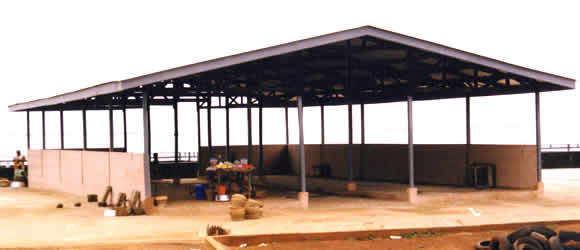 Artisanal fisheries are small-scale fisheries for subsistence or local, small markets, generally using traditional fishing techniques and small boats. They occur around the world (particularly in developing nations) and are vital to livelihoods and food security; particularly of surrounding communities. Comparatively, worldwide, artisanal and commercial fisheries catch the same amount of fish for human consumption (30 million tons), yet artisanal fisheries employ 25 times the number of fishers (over 12 million people) and use an eighth of the amount of fuel used by industrial fisheries annually (Jacquet and Pauly, 2008).
Artisanal fisheries are small-scale fisheries for subsistence or local, small markets, generally using traditional fishing techniques and small boats. They occur around the world (particularly in developing nations) and are vital to livelihoods and food security; particularly of surrounding communities. Comparatively, worldwide, artisanal and commercial fisheries catch the same amount of fish for human consumption (30 million tons), yet artisanal fisheries employ 25 times the number of fishers (over 12 million people) and use an eighth of the amount of fuel used by industrial fisheries annually (Jacquet and Pauly, 2008).
challenge
Artisanal fisheries can also have a significant negative impact on marine ecosystems – overfishing, habitat damage, and bycatch – but, because they are much more efficient than commercial fisheries, they are also the world’s greatest hope for achieving sustainable harvests.
Understanding and reducing the impacts of artisanal fisheries on marine ecosystems is a rapidly emerging priority for marine conservation. In the context of degrading ecosystems, increasing fishing effort, and growing human populations, there is urgent need to develop sustainable management strategies for artisanal fisheries. It is critical that we obtain the data necessary for assuring sustainable fisheries management. This requires interdisciplinary research that considers the ecological, socioeconomic, and cultural aspects of artisanal fisheries. In many developing nations, infrastructure and resources available for research, management, and monitoring are severely limited. Further, the inherently decentralized nature of artisanal fisheries poses significant challenges to each of these efforts. Communication and collaboration among scientists, projects, regions, and disciplines are critical if research is to contribute to effective, well-informed management. (Scripps Institute of Oceanography, 2014)
Primary AFWIN Beneficiary: Keta Lagoon
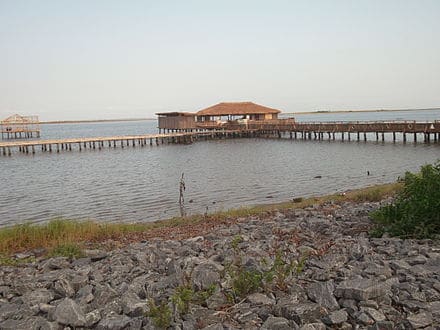 Keta is located along the current delta of the Volta River in eastern Ghana. The lagoon and surrounding wetlands are heavily utilized by a large population of people who fish using a variety of techniques, cut reeds for thatch and weaving, harvest salt by intensive and extensive means, and irrigate vegetables using water drawn from shallow wells in the surrounding sandy soil.
Keta is located along the current delta of the Volta River in eastern Ghana. The lagoon and surrounding wetlands are heavily utilized by a large population of people who fish using a variety of techniques, cut reeds for thatch and weaving, harvest salt by intensive and extensive means, and irrigate vegetables using water drawn from shallow wells in the surrounding sandy soil.
The lagoon is also an important habitat for many aquatic and wetland animals and species and has been recognized as internationally important under the Ramsar Wetlands Convention. However, increasing exploitation of the lagoon and its resources has resulted in degradation and raised concerns about the long-term sustainability of these systems, concerns being addressed by the Ghana Coastal Wetlands Management Program (CWMP) funded by the Global Environment Facility. Keta Lagoon, with an important water area of 300 km2, the largest lagoon in Ghana, is located in a far larger wetlands protected area of 1200 km2 – stopping point for a large number of migratory birds and a breeding ground for sea turtles.
It is also the most important water bird site along the entire Ghana coast with a record of 72 species of resident and migratory birds. The Keta Lagoon and its surrounding wetlands qualifies as an internationally important wetland under the Ramsar criteria by virtue of its total bird population of around 110,000 and the fact that it supports internationally important eight species of migratory waders. The potential for marine science, ornithological and other studies has not been developed, nor has the great potential for international niche tourism, including, but not limited to bird and turtle watching, sport fishing and ecological tours.
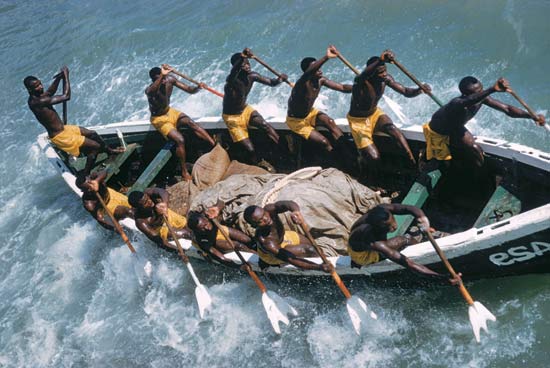 Economic Role
Economic Role
The lagoon contributes significantly to the economic well-being of the people – a vital link in food security. It provides livelihood through fishing and boat transportation from Keta to Anyako and Afiadenyigba. Salt winning, formerly an artisanal activity, common in years of low rainfall, has now been industrialized, with a concession given to a USA corporation. Although the benefits to the community and ultimate effects on the Keta Lagoon are debatable, the industry does represent a step forward in better utilization of native resources. Coconut trees abound close to the coastal areas, their nuts a source of food, and oil, extracted from copra. An opportunity also exists for turning aquatic reeds harvested by women into bags, mats and other handicrafts that will provide alternative livelihoods to generate income – especially for women. At the same time, establishing local arts and crafts inevitably increases the tourist appeal of Keta and its historic lagoon.
Spiritual Significance
The practitioners of the traditional Anlo belief system have a strong spiritual attachment to the lagoon. It is believed that the lagoon has gods who must be worshiped if the people wish to get abundant catch. One of the gods is called ‘Gbele’ where the people of Anlo Afiadenyigba once every year perform some rituals for the lagoon. At times, a live cow is cast in the lagoon to guarantee a bumper harvest. On occasions when children are drowned while swimming and people go missing during fishing expeditions, the accidents are attributed to spiritual forces. Although some fishermen attribute declining catches to social-spiritual causes such as conflict in the community or as punishment from the gods, most fishermen are aware of excessive fishing as a cause for declining catches.
Biodiversity Conservation
Important in conserving several species of mangroves, crabs, shrimps and raffia plants, the Keta Lagoon hosts a variety of fishes from the marine environment and from rivers. It is a spawning zone for fingerlings and the habitat is conducive for native fishes. With seasonal inflow of sea water, marine fishes migrate to breed in the calmer waters of the lagoon, especially the safe haven provided by the mangrove swamp section.
Bird Life
The Keta Lagoon is the most important wetland on the Ghana coast for water birds and together with the neighboring Songor Lagoon, constitutes the fourth most important water bird site on the Gulf of Guinea coast, supporting 76 waterbird species with an estimated total population of well over 100,000, including globally significant numbers of 21 species. The site is particularly important for waders, supporting almost one third of the estimated East Atlantic Flyway population of the Spotted Redshank (Tringa erythropus). Herons and egrets occur in large numbers. The most important parts of the lagoon for waterbirds are at Fiahor, Woe, Tegbi, Adina and Afiadenyigba.
Freshwater & Marine Fish in Keta Lagoon
A total of 18 fish species belonging to 13 families have been studied. Four of the species were found to be commercially important notably, the cichlids (Tilapia guineensis and Sarotherodon melanotheron), the Bonga shad, (Ethmalosa fimbriata) and the blue-swimming crab, (Callinectes amnicola), the most important shell fish. (Ghana Journal of Science)
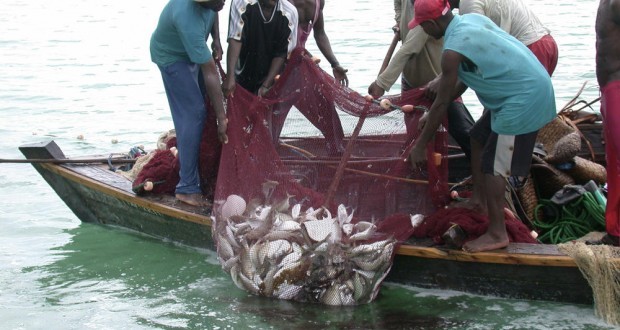
Other freshwater species encountered are Nile Tilapia (Oreochromis niloticus), Redbelly Tilapia (Tilapia zillii, an aquarium fish, also converted to fishfood). Juveniles of the flat sardine (Sardinella mardrensis), mullets (Mugil curem & Liza falcipinn), as well as Crevalle Jacks (Caranx hippos – a superb, light-tackle game species and fearful predator) were encountered. After the Sea Defense Project was completed, the lagoon was dredged and regained economic importance. An open link was created with the ocean to enable shrimps to swim into the lagoon. The protected environment allows shrimps, a staple of the Keta fish market, to increase in size quickly. The lagoon is an important nursery ground for numerous species of fish.
Methods of Fishing
In a recent scientific study, the most encountered fishing gear were brush parks (Acadja) (29.1 %) and basket traps (23.2 %), whilst the least occurred gear was the encircling net (1.8 %). Cast nets are commonly used in the lagoon, as well as hook and line. When the lagoon waters are low, fish are caught by hand.
Need
There are two inseparable sets of needs. The first is that of the health and future of Keta Lagoon. The second, the Economic Well-being of the Fishermen, including their health, that of their families, and the Keta community, at large.
Keta Lagoon
Fisheries in the Volta Region are largely an ad hoc operation, inefficient, un-protected, largely unsupervised, and without any form of management. They are affected by habitat degradation, over-fishing, and pollution, all of which cause changes in the size and structure as well as species composition of the catches. Most of the red and white mangroves around the lagoons have been cut down for fuelwood or to create salt pans. Thus the spawning, breeding and feeding sites of fishes, which shelter, reproduce and grow in the roots, have been and continue to be destroyed.
Fishermen use smaller mesh nets in fishing as a means to increase their catch. To counter depletion of stocks, fishing is not permitted on Tuesdays, and in some towns bordering the lagoon, is banned on Sundays and before certain festival times. Enforcement is difficult and half-hearted, promoting the typical self-destructive downward spiral observed in countless impoverished communities. Despite its evident importance at many levels, the government focuses not on artisanal, but marine fishing and fish farms – where, off-shore or in the Volta Lake, species such as Tilapia are pellet-fed and raised in cages.
The artisanal fishing component is distinguished by the absence of strategic planning, suitable material, poor organization and no efficient structure for selling the catch. This is exacerbated by a large, bycatch (often thrown away on shore), and spoilage of a large percentage of what is caught. Modern boats, motors and nets are virtually non-existent.
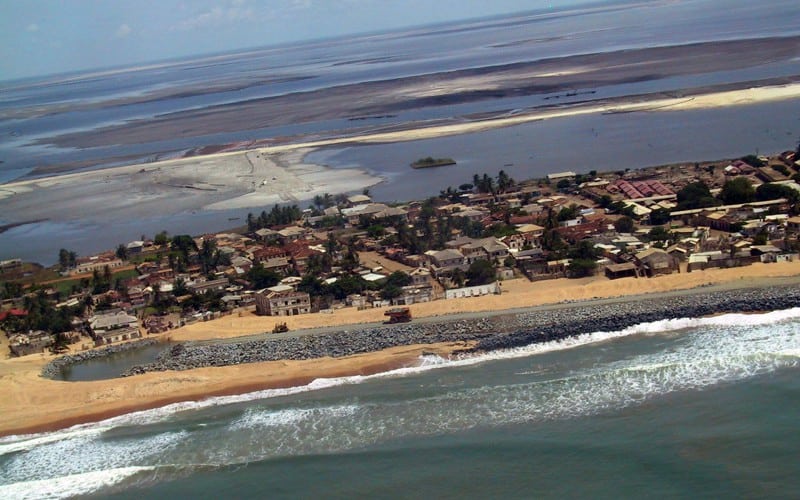
Solutions
The Institute
It is imperative that holistic sustainable solutions be found to the current problems in order to increase productivity, eliminate wastage and maximize revenues. Our plan is precisely that: Creative, pragmatic solutions that will be welcomed by the fishermen and the community.
It is with this critical economic, social and environmental disintegration in mind that we plan to build, equip and staff the first Keta Lagoon Artisanal Fishery and Wildlife Institute (KLAFWIN), an environmental, economic, social, scientific and informational resource designed to create opportunities for ongoing scientific studies, species and environmental protection and information and education center.
KLAFWIN is designed to first check, then reverse short-term exploitation of the finite and rapidly dwindling natural resources, while ensuring sustainability. Medium-term, it will increase diversity and productivity of the Keta Lagoon natural resources, through encouraging traditional biodiversity. Collecting, collating, analyzing and extrapolating information on a daily basis from Keta Lagoon fisherman will provides an invaluable, heretofore non-existent data base. Long term, this will lead to an effective management of Keta Lagoon resources.
The proposed facility, constructed on the shore of Keta Lagoon, just 20 meters from where fishermen land their catch, will initially consist of adjacent purpose-built polyvalent buildings. As the scope of the operation expands, a pond complex will be built to be used for fishery research, production, aquaculture and education. The facility will house multiple components including a visitor welcoming area. This will feature Keta Lagoon and local information including nature tours, bird and turtle watching. Additionally, to profile the center, with views over the fish landing area, sport fishing specialists/guides will advise and assist in booking excursions from fly and light tackle in the lagoon, to Indian Ocean deep-sea fishing charters for marlin, tuna, halibut, Mahi- Mahi, Emperor, grouper, barracuda, bonito, etc.
Facilities will include support space for staff and collaborating researchers, a basic dispensary, outdoors showers and covered toilets for fishermen and visitors and, long-term, a hatchery complex.
Economic and General Well-being of the Fishermen
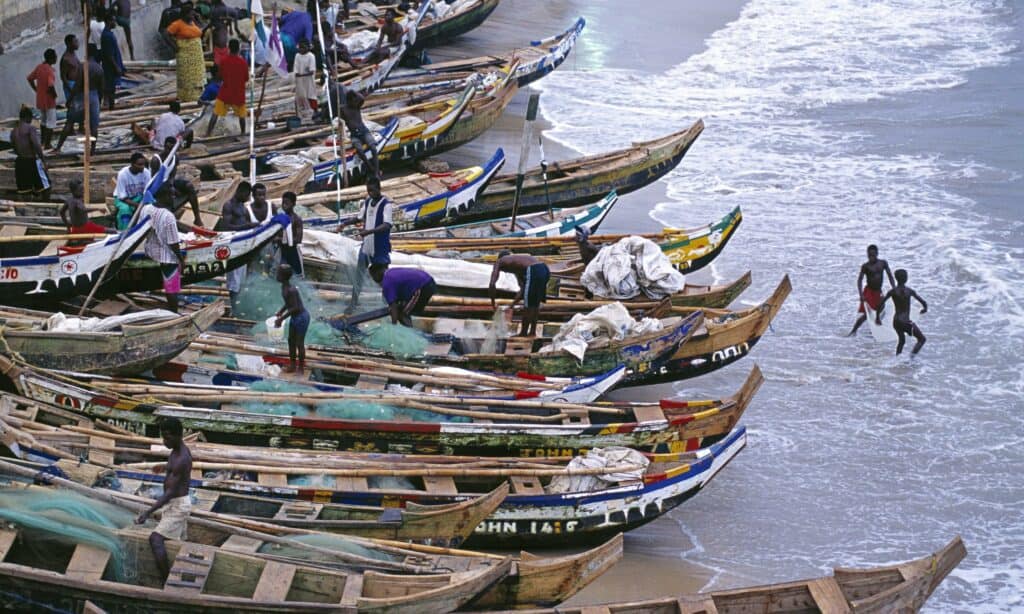
The benefits of the Keta Lagoon KLAFWIN program will be reflected in a better quality of life for the fishermen, their families, and Keta. Subsidies are not the answer, but rather, a healthy free market economy. At the moment, with only limited means of disposing of their catch – which is highly perishable with no refrigeration and daily temperatures in the high 20s and 30s – either the fishermen attempt to directly or indirectly sell it on the Keta market (two days a week), or consume it within the family. Most spoils and is thrown away.
Weekly Keta Lagoon fish and produce market. We plan to construct a fresh fish, vegetable and fruit market on the KLAFWIN site, open 4 or 5 days a week, primarily oriented to the Accra and Volta Region food trade, including hotels, restaurants and retailers, who would register with the market to get Cash & Carry discounts. The trade would receive electronic daily reports of the catch, prices and details of other products on offer. Electronic means of payment would be established, permitting the trade to reserve goods.
To enable this system to function, the whole fish, shell fish or crabs, prawns and shrimp must be prepared for the market – i.e. rinsed clean and displayed on ice. Unsold fish will be cleaned and go into cold storage until the next market, where they are offered at a reduced price. Dating of the catch will guarantee quality.
Fishermen receive a delivery chit and voucher based on the estimated price to be realized for the sold fish, which they can cash after one week. Payment is made from revenues from sold fish, shellfish, crabs, shrimps and prawns. A credit is given for bycatch – numerous species, which for traditional or ethnic reasons, the people bordering the lagoon will not eat, but which have a market value.
Since a number of fishermen fish both off shore (pelagic/ medium depth, medium – small species) and in the lagoon, the Keta Lagoon market will integrate a selection of their catch. This expands both the selection and viability of the market, and the base of local support.
Team
Norris Hill & Partners
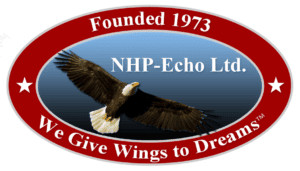 NHP-Echo Ltd. is a cutting edge Ghanaian corporation, headquartered in Ho, Volta Region, the result of a fusion of Norris Hill & Partners (founded 2006) and Echo Contract Works Ltd., incorporated over 40 years ago by distinguished Chairman, Crossly K. Addor. Echo, a pioneer in the construction, civil engineering and plumbing industries, was a key factor in Volta Region infra-structure development.
NHP-Echo Ltd. is a cutting edge Ghanaian corporation, headquartered in Ho, Volta Region, the result of a fusion of Norris Hill & Partners (founded 2006) and Echo Contract Works Ltd., incorporated over 40 years ago by distinguished Chairman, Crossly K. Addor. Echo, a pioneer in the construction, civil engineering and plumbing industries, was a key factor in Volta Region infra-structure development.
Fortune Norris Addor – Fortune’s apprenticeship took place in Echo Contract Ltd, a leading Ho, Volta Region, road building, residential construction and engineering company, founded by his father, Crossly K. Addor in the 1970s. He earned a B.Sc. in Business Management from the University of Ghana in Accra, followed by Business Studies at MSBM, in London, before joining a French high tech energy company as African Development Manager. Fortune, co-founder of Freedom University Keta, represents Norris Hill & Partner as Managing Director in Africa.
Michael Flannery – Michael studied languages & economics at the universities of Vienna, Heidelberg & the U.S. Navy Intelligence School. He took part in seminars under Nobel Prize winner, William Faulkner at the University of Virginia and studied under Cyrus Hoy at Virginia and Vanderbilt University. A graduate of Thunderbird School of Global Management, he has held directorships in international consumer products, design & advertising corporations. His historical work, Golf Through The Ages: 600 Years of Golfing Art, is the standard reference for sporting art & European ball games, 1120 – 1890. He is a Partner in Norris Hill & co-founder of Freedom University, Keta.
Keta Foundation
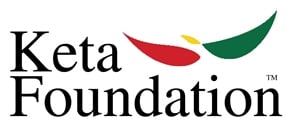 Gavin P. Smith, Executive Director of the Keta Foundation, holds a Master of Global Management with distinction from Thunderbird School of Global Management; an MBA from the College of William & Mary Mason School of Business; and a BA in History from Wake Forest. A global professional and consultant with 20 plus years of experience in digital marketing, award-winning broadcasting and journalism, Gavin is also Executive Consultant to Freedom University Keta.
Gavin P. Smith, Executive Director of the Keta Foundation, holds a Master of Global Management with distinction from Thunderbird School of Global Management; an MBA from the College of William & Mary Mason School of Business; and a BA in History from Wake Forest. A global professional and consultant with 20 plus years of experience in digital marketing, award-winning broadcasting and journalism, Gavin is also Executive Consultant to Freedom University Keta.
Support
Cooperation with Ghana’s Ministry of Fisheries and Aquaculture, we are being advised by Ghana Coastal Wetlands Management Program (CWMP), Ghana Wildlife Society, the Wildlife Division of the Ghana Forestry Department, experts from the University of Ghana, Scripps Oceanographic Institute and neighboring Benin and Togolese marine biology experts. The Keta Municipal Assembly endorses and fully supports KLAFWIN, while strategic construction partners including ICE (International Home Exports, California, specialists in pre-engineered Light Steel Frame construction, will purpose-build and ship the state-of-the-art finished buildings at a considerable savings over conventional construction.
Support
Cooperation with Ghana’s Ministry of Fisheries and Aquaculture, we are being advised by Ghana Coastal Wetlands Management Program (CWMP), Ghana Wildlife Society, the Wildlife Division of the Ghana Forestry Department, experts from the University of Ghana, Scripps Oceanographic Institute and neighboring Benin and Togolese marine biology experts. The Keta Municipal Assembly endorses and fully supports KLAFWIN, while strategic construction partners including ICE (International Home Exports, California, specialists in pre-engineered Light Steel Frame construction, will purpose-build and ship the state-of-the-art finished buildings at a considerable savings over conventional construction.
What success means
Success means that we:
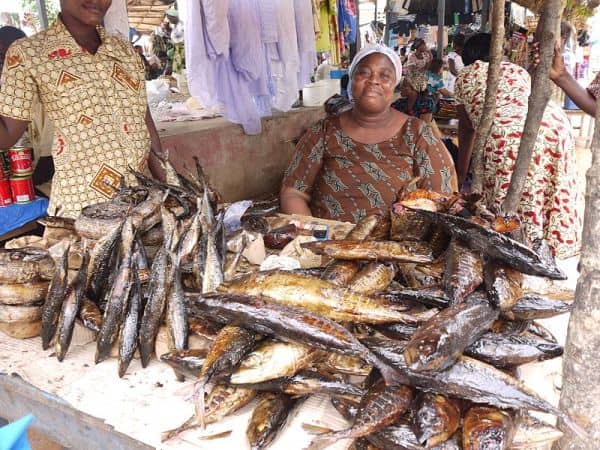 Engage, educate and reward fisherman, produce growers and craftsmen who participate in the system. These are our disciples in the community and the backbone of our efforts.
Engage, educate and reward fisherman, produce growers and craftsmen who participate in the system. These are our disciples in the community and the backbone of our efforts.
- Employ evidence-based research and development in the Keta Lagoon to result in catches of a better mix and quality on a sustainable basis. Fisherman, their families and the community benefit directly from these programs.
- Dramatically reduce the waste produced through by-catches.
- Provide food security for the community.
- Create jobs. This goes hand in hand with the establishment and expansion of AFWIN.
- Establish new trades including fishmongers and guides for light tackle game fishing.
- Educate the community on best environmental and conservation practices for the protection and health of the Keta Lagoon.
- Promote better health through hygiene, accessible medical treatment and on-going informational programs at the clinic, including nutrition, child-birth, dental care, disease prevention, gender equality and much more.
- Through the virtually daily collection, collation and analysis of catches and information on Keta Lagoon conditions, establish an invaluable and unique data base, with relevance for artisanal fisheries and similar lagoons in Ghana (an estimated 50 – 100) and internationally.
- Establish Keta Lagoon KLAFWIN as a focal point not just for marine environmental studies, but a primary national and international tourist destination, resulting in additional capital being regularly injected into the community.
We anticipate that through profits on sales from the fishery, boat rental, guide fees and other activities, that the Keta Lagoon Artisanal Fishery and Wildlife Institute (KLAFWIN) will be largely self-sustaining by 2019, and will be providing jobs and income – directly and indirectly – for as many as 500 men, women and youth.
Key Success Factors
Keta Lagoon Artisanal Fishery and Wildlife Institute (KLAFWIN) is designed to maintain the ecological integrity of this key coastal wetland area, by involving the people who derive their livelihood from these ecosystems in the planning and implementation of a dynamic management program. At the same time, it rewards them by integrating KLAFWIN into a modern, imaginative marketing system, through which spoilage is dramatically reduced, and a fair price obtained for a larger net catch.
